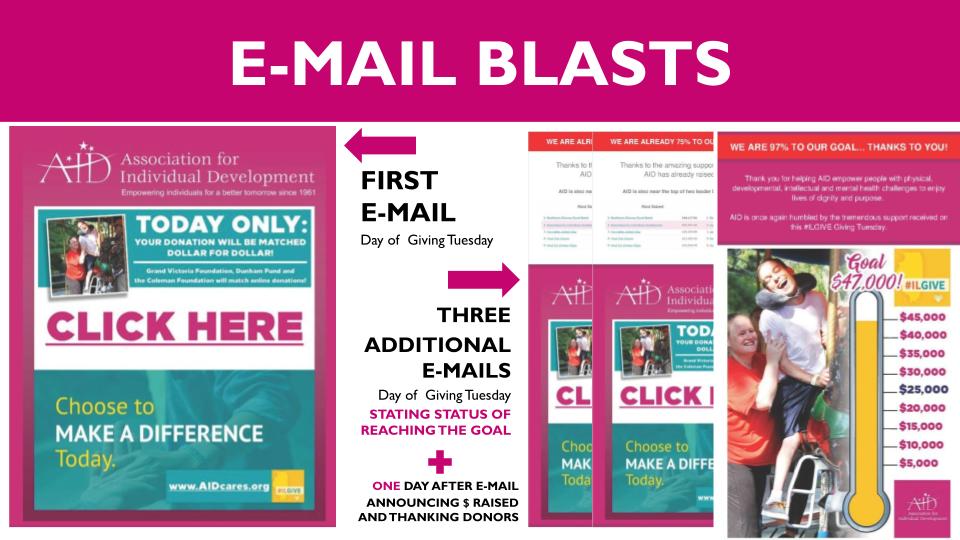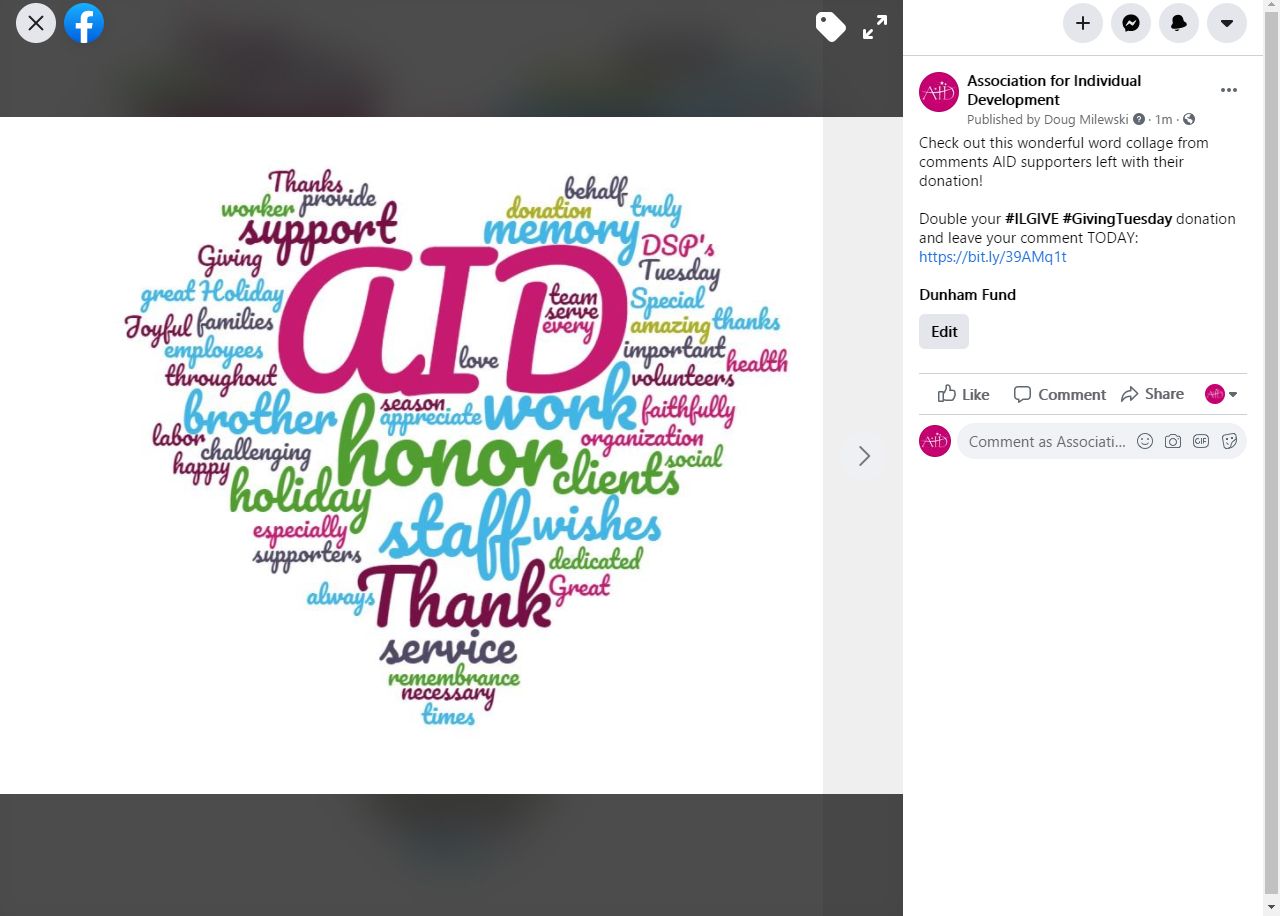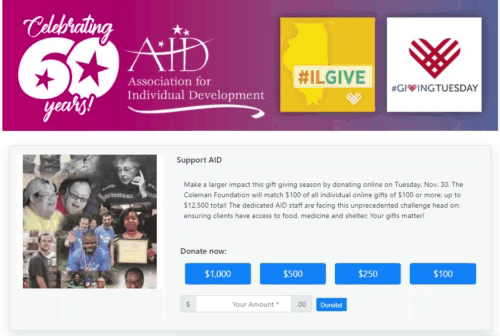The first Giving Tuesday Association for Individual Development (AID) participated in 2015 yielded $5k. As Giving Tuesday has become much more widely recognized, so too has the success of the AID end-of-year campaign. Tying it in with Giving Tuesday helps increase awareness and reach a larger audience. The national and global push of Giving Tuesday has positively affected the AID campaign and year over year proceeds have increased. Last year, AID saw more than $70K in contributions and hope to reach a similar goal again this year.
Doug Milewski, AID Marketing and Communications Specialist, is confident they will exceed the goal with the help of key strategies:
- Communications
- Matching gift
- Goal setting
- User-friendly digital giving platforms
Customizing messaging based on audience
Ask the right people, in a way that makes it easy for them to make a donation. Donors who make a year-end gift may be different than those who attend an event or volunteer their time. Customizing messages ensures each donor gets the right message on the right communication platform; enhancing engagement.
AID uses multiple communication platforms to connect with donors. It’s important to recognize how various members of your audience contribute to your organization and utilize any and all avenues available to reach your entire donor base.
Historically, Email is the single most effective tool for fundraising. An email conveying a clear message and a call to action gets opened, read, and links clicked. The email marketing application that AID uses allows them to set up the campaign and send out 5 email messages leading up to the day. Then on Giving Tuesday they will provide updates throughout the day tracking the goal status. You cannot over-communicate when it comes to your mission. If people unsubscribe then they probably were not going to donate anyway. That’s ok, it lets you focus on those who will. AID donors are giving money to support services to individuals with developmental, behavioral and crisis needs across Kane, Kendall, DeKalb, DuPage, Will, McHenry and suburban Cook County communities. They deserve to know and see how their donations are being utilized and making a difference.

Social media continues to tell the story. Facebook and Twitter give AID a beautiful running dialog with their supporters. They share stories, videos, testimonials. They thank supporters, donors, and sponsors. The AID social media channel lets donors know that their gifts are appreciated and used to support AID programs and services.
Use hashtags that are meaningful. AID uses both #GivingTuesday and #ILGive. #ILGive is recognized by Illinois residents as their local giving hashtag. Plan the Giving Tuesday social media in advance so that all posts are timely.
Doug updates the social media page throughout the day to show progress and encourage others to give.


At the end of day he posts a word collage that he created using all the kids words left by donors. A complete social media strategy keeps them on track.

Matching Gifts Double the Donations
AID actively seeks and secures grants and matching funds for giving campaigns. For this year’s Giving Tuesday they applied for and secured matching funds from The Coleman Foundation. For every donation of $100 or more, Coleman will match $100 (up to $12,500 total). Even more generous is that the grant will match gifts made throughout the entire month of November!
Large foundations have money they want to infuse into the community. These funds tend to be localized and aligned with the foundations core values. For instance, The Coleman Foundation is a private grantmaking entity that invests in ideas and initiatives that improve the lives of individuals in the Chicago metro area. They engage with organizations that work in their three areas of focus: entrepreneurship, cancer care and health habilitation services, and developmental disability service organizations. The Coleman Foundation funds projects that help organizations serve their communities more effectively.
Applying for a matching grant program often takes time and planning and usually includes an application process. AID was kind enough to share a few slides from their grant application that are featured below in this article showing their messaging, email and social media plan.
Take the time to find your match! Once you apply and secure funds the first time you can more easily reapply in subsequent years. Remember that grant funds or matching gift incentives usually require progress reporting and accountability.
Here is how AID brought this to life on their Giving Tuesday donation page:
Make a larger impact this gift giving season by donating online from Nov. 1 - Nov. 30. The Coleman Foundation will match $100 of all individual online gifts of $100 or more; up to $12,500 total! The dedicated AID staff are facing this unprecedented challenge head on; ensuring clients have access to food, medicine and shelter; Your gifts matter!

Goal Setting
Budgeting sounds so boring, and tedious however using the data will set you up for success. Look at the previous fundraising activity. Where were the surges in giving, what messages, to whom, and when did the call to action turn into donations? What if you set the goal or thermometer on the page too low and hit the goal? Will people still give? Paint the picture to show how additional donations will continue to fund.
Easy to Give
Making the donation process as simple as possible is vital to a successful Giving Tuesday campaign. A single donation page that encompasses the story and a fast pathway to donate makes it easy for the donor to say yes and make a contribution. Brand the giving page with the organization and Giving Tuesday (and in this case #ILGive) to provide even more weight and fidelity to the charity or non-profit.
Because the match is such a large part of the campaign be sure to recognize the matching foundation as well. Again, more credibility, more reason to give. Supporters can easily see how their dollar can double with a match.
A single landing page for giving is a best practice for any donation campaign. Click, give, done! AID is using Auctria because it is a quick set-up and they already are using the platform for their annual Auction Gala fundraiser. Many donation platforms take 5%-6%, Facebook does not ‘charge’ for fundraising however they do take much longer to send the funds. With Auctria, the Giving Tuesday event can be created with a single click and ready to go out of the box. AID did a little more to brand their giving landing page.
Networking
Always be networking. A solid fundraising strategy enables you to capitalize on opportunities as they arise. For instance, Doug is always on the lookout for opportunities to help share the AID message. One year he secured a donation for a full-size billboard on a busy thoroughfare. Already having the Giving Days general messaging and images established, he was able to quickly mobilize and take advantage of the opportunity.

Special thanks to Doug Milewski for sharing how Association for Individual Development creates and implements their Giving Tuesday campaign.
Celebrating 60 years of providing customized, consumer-focused programs and services in an equitable, inclusive manner, the Association for Individual Development (AID) works with individuals with developmental, intellectual, physical and/or mental health challenges, those who have suffered a trauma, those experiencing immediate and/or chronic crises and those at risk to overcome personal, behavioral, societal and environmental barriers to achieve recovery, independence, self-reliance and to live the lives they choose. Operating in Kane, Kendall, DeKalb, DuPage, Will, McHenry and suburban Cook County communities, AID is accredited by the Commission on Accreditation of Rehabilitation Facilities (CARF) and the American Association of Suicidology (AAS).
In FY 2021, AID served 6300 people in client-centric, community-based programs. AID currently operates community centers in Elgin, Aurora, Batavia, Sugar Grove and Yorkville, mental health outpatient clinics throughout the Fox Valley, supports 1000 individuals living in their own apartments, and more than 220 individuals in 3 dozen group homes scattered throughout the greater Fox Valley. AID collaborates with Federally Qualified Healthcare Centers (FQHCs), managed care companies, Frequent Users (FUSE) programs, Continua of Cares and local hospital systems to decrease homelessness, increase employment and improve the mental and physical health of residents.
